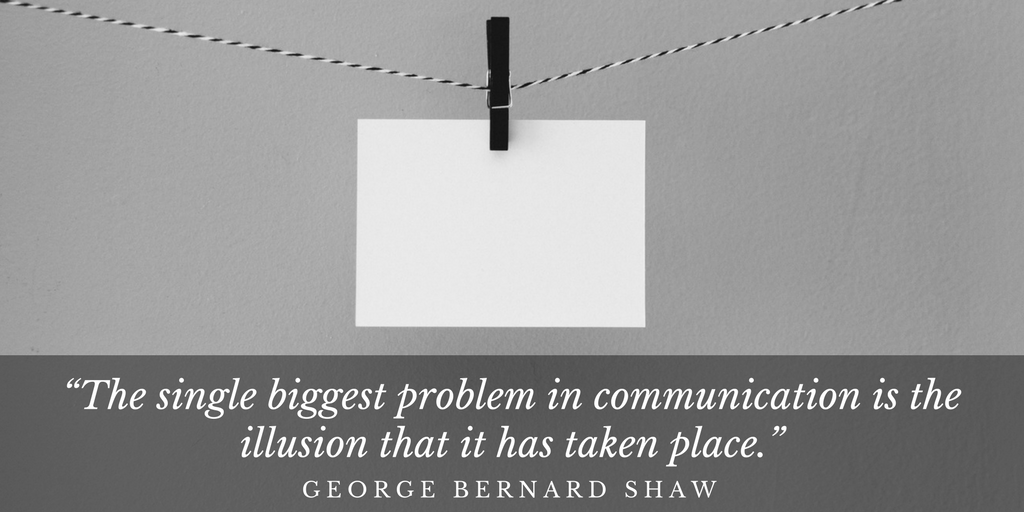Everything about communication seems so easy. I can create sentences without even thinking. I can gather images to make a point. I can deliver those in a variety of forms. It’s easy.
Except it’s not.
Communication isn’t just delivering the message. For it to be communication, the other side has to understand.
I can remember countless times I’ve sat through talks with no communication. I heard every word, but it wasn’t effective. It didn’t stick.
While I try to be a good communicator, I know I fail more often than I’d like.
Part of the challenge is that everyone has a different filter that determines how they hear you.
-
Their mood.
-
The thoughts running through their head.
-
Their level of experience and knowledge.
-
Their beliefs.
-
The list goes on and on.
Combatting these filters can be difficult. Unfortunately, communication is getting harder in our society thanks to endless distractions.
Focus
If you were to walk into any company in the world and wander around, eventually you’d find a meeting room. In that room you have people that took time out of their day to gather and discuss some important topic. If it wasn’t important, they wouldn’t be meeting in the first place.
Unfortunately, you will see half of the room, if not more, checking their phones and computers. This small act stops communication in its tracks.
We all believe we can do two things at once. It’s called multitasking. Study after study shows that this is not true. Neuroscientists tell us that our brain cannot focus on more than one thing at a time.
But, we are able to shift our focus from one thing to another crazy fast. This creates the illusion that we can multitask.
Knowing this helps me remember to turn off the distractions so I can focus on what I’m hearing.
Empathy
Someone smart said you have to “know your audience.” This is true whether you are making a public speech or talking to someone 1-on-1.
To me this is imagining the world through their eyes. What filters do they use to see the world? How do they feel about a particular subject? How might they react to a particular message?
By going through this exercise I can think through the best way to get my points across.
Repetition
The Rule of Seven is famous in advertising. It says that someone needs to hear or see your message at least seven times before they will buy your product.
I’ve found the same thing to be true when I’m trying to get messages across inside a company.
A few years back we were creating a new website and we knew 2/3rds of our traffic came from mobile phones. To make sure we created the best experience for a small screen, I wanted the team to think “mobile-first”.
We had a team meeting and I thought I had made it clear what this meant. A few days later we sat down to review new designs and they were for a desktop, not a mobile phone.
Then, as I walked around the office, I noticed everyone had the site up on their large monitors. Whether they were running a test or considering a design, it was all on the big screen, not mobile.
I repeated my mobile-first mantra over and over. It was setting in, just not fast enough.
So I took one final step and delivered the message in a new way. I banned myself and the rest of the team from looking at our site on laptops. This got everyone’s attention and finally did the trick.
Clarity
In the business world, we all love to use jargon. These words sound impressive, but they complicate communication. When I would write or talk I was notorious for overusing these types of words.
Lately I’ve been trying to simplify all my communication to make it more clear and to the point. After all, communication is about what the other person hears, not what I say.
Albert Einstein said it well, “If you can’t explain it simply, you don’t understand it well enough.”
Writing
Today, the majority of our communication happens over some electronic form, like email.
My first rule of thumb is to avoid these mediums if possible. A live conversation always beats an electronic one. Part of the reason is nonverbal communication.
Research shows that over 90% of communication is nonverbal. It’s impossible to communicate tone or body language in email. These factors help people receive the message, so it’s always the best place to start.
When I do write, I try to take the time to do it well. Of course, sometimes I don’t have the time and I do a poor job.
Blaise Pascal, is famous for saying, “I would have written a shorter letter, but I did not have the time.”
It’s hard to get your thoughts down on paper. Email is a great example of this. One study from 2009 found that the average email has over 600 words! The Gettysburg address, one of the most famous speeches of all time, had half as many.
Listening
When I’m having a live conversation I work to make sure I understand what is being said. One way I do it is to play back what I heard.
For example, I might say “Let me see if I have this right, you’re saying…” The simple act of paraphrasing back helps me understand and clarify what is being said.
If I’m on my game, I’ll go further and ask questions. These help me understand how the other person got to their point of view. Often times, these questions uncover interesting facts besides helping me understand.
Assumptions
There is a great quote on what happens when you make assumptions. Since it involves a curse word, I’ll leave it out. Let’s just say that assumptions cause a lot of problems when it comes to communication.
I see it everyday at work. Assumptions get made about who is going to do a task. Assumptions get made about when something is due. Assumptions get made about what is important.
Assumptions create ambiguity and it’s impossible to have good communication when this exists.
Positivity
Most people I meet are terrific. They’re a pleasure to be around and I enjoy talking to them.
Every once in a while, I’ll come across someone that is angry, unlikable or just unhappy.
In these situations I find myself blocking out what they say. Their negative attitude turns me off. This creates a barrier to communication.
This is one of the reasons I try to excude positivity. I do simple things, like smile a lot. This all helps open up the other person to receive my message.
Communication is hard and I still struggle to get better. With all the changes in technology, it keeps getting harder. The best thing I know to do is to keep learning, be truthful with myself about how I’m doing and focus on getting better.
This post is part of a series of letters to my kids. My goal is to reflect on and capture as many life lessons as possible. Here is the current list I am working from.



